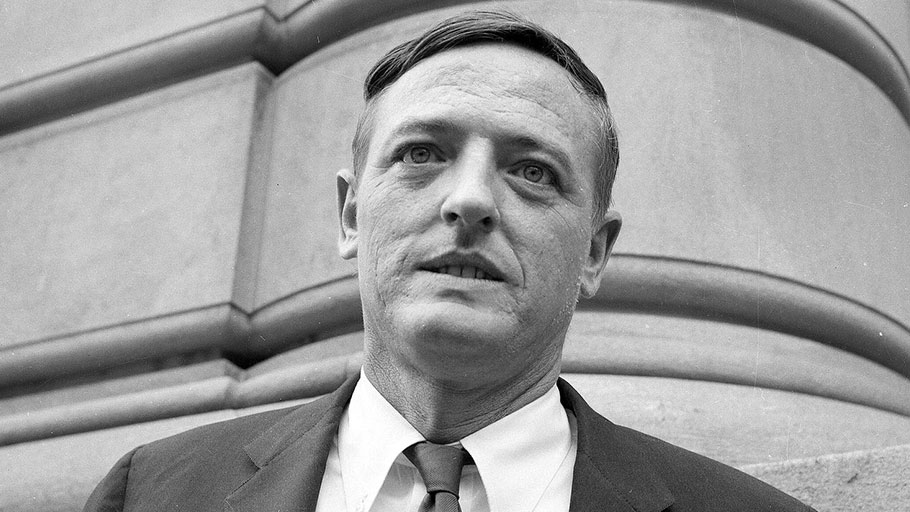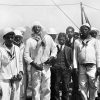William F. Buckley, Jr., Conservative Party candidate running for the office of Mayor of New York City, is shown outside the Overseas Press Club on Oct. 20, 1965. Buckley and his National Review magazine helped shape conservatives’ self-conception of their racial positions. (AP Photo)
How the right created the illusion of colorblindness.
By Joshua Tait, The Washingtion Post —
Americans are at an impasse in their understanding of racism today. The activist slogan “Black Lives Matter” is met by the rejoinder “All Lives Matter” or “Blue Lives Matter.” Colin Kaepernick’s NFL protest about racial injustice is perceived only as an anti-American blast. President Trump tells reporters he is “the least racist person” they will ever interview. In each of these cases, conservatives feel deeply that they are not the bigots they are made out to be, declaring wide-eyed innocence in the face of any charge of racial animus.
This claim to racial innocence is not a new feature of the conservative movement, but rather one woven into the development of modern conservatism, part of an effort on the right to cleanse itself of its support for segregation and other racist policies, while heaping the blame for any racist outcomes in American society on their opponents on the left.
That process of racial purgation was captured in the pages of conservatism’s foremost intellectual outlet: National Review. In April 1965, William F. Buckley Jr., who founded National Review as a journal of “respectable conservatism,” spoke to a police breakfast in New York. Buckley reportedly praised the Alabama police for their restraint at Selma. The episode sparked fierce press condemnation.
Furious, Buckley held a news conference where he played a recording of the speech. The tape undermined reports that the police had cheered Buckley’s remarks about police violence, but the talk did defend the Alabama police, despite reservations about excessive force, and placed blame on civil rights activists for the confrontation.
It was really the charge of bigotry that incited Buckley. He hadn’t breathed “a word of prejudice against any people” he said in a statement. And he wanted to sue.
“If the Liberals succeed in anathematizing me as a seller of hate,” Buckley told the directors of his magazine, then “so is National Review.”
“If we show that we don’t care that people call us hate-peddlers, then, in a way we care less about hate-peddling,” he said.
As far as Buckley was concerned, National Review and respectable conservatism were at the fulcrum of genuine racial enlightenment: “non-racist” yet not ensnared in “dogmatic racial egalitarianism.”
The reality, however, was much more complex.
During the 1950s and 1960s, the editors at National Review steadfastly opposed the “ludicrously named” civil rights movement. Trained in political philosophy, the National Review editors adhered to an ancient distinction between civil and political rights while the “Negro revolt” blurred these rights together. Throughout, the editors maintained a self-deceptive innocence about racism that remains essential to conservatives’ self-image.
In its earliest days, National Review defended Southern segregation in euphemistic terms. Buckley published articles by highbrow segregationists praising the conservative South as a check on liberalism. In perhaps its most infamous editorial, National Review asked whether whites should dominate in the South. Its “sobering answer”? Yes.
The editorial held that the civilization of the South would be degraded if black people were allowed to exercise their right to vote. White Southerners should not exploit their cultural superiority by keeping African Americans down for their own advancement. But they could deny “socially atavistic” African Americans their political rights.
The editorial was challenged in the subsequent issue by another editor: Brent Bozell, Buckley’s brother-in-law. He called it “dead wrong” for pitting conservatives against the constitutional right to vote. Buckley responded in print that there was indeed a gulf between the white Southern culture and “Southern Negroes in their present stage of development.” He suggested a way forward might be to deny the vote to both “marginal” blacks and whites.
National Review’s editorial line on racial issues shifted in the 1960s toward a “colorblind” constitutional strategy. In part, this change reflected the moral case made by civil rights activists that laid bare the brutal realities of Jim Crow.
National Review still lambasted Brown vs. Board of Education on its 10th anniversary and consistently opposed every stage of the civil rights movement. But the magazine did occasionally refer to the “plight of the Negro” or the justness of the anti-Jim Crow cause. It defended boycotts and voting as legitimate (though the magazine criticized freedom riders for knowingly provoking white violence). It disparaged segregationist leaders like Ross Barnett and George Wallace for being uncouth and insufficiently committed to free enterprise.
In 1962, Buckley hired his first black staff member, a young woman named Myrna Bain. She told the Village Voice that “you can’t believe in our Constitution and be a segregationist,” reflecting National Review’s newfound commitment to colorblind constitutionalism.
Colorblindness served conservative purposes. It allowed not only conservative writers but politicians like Barry Goldwater to oppose civil rights legislation from a “race-neutral” standpoint, in line with broad American values. They could always point to a higher principle than racism — whether constitutional or otherwise — to explain their opposition to black demands for equality.
In the summer of 1963, in the midst of one of their regular “Agonies,” where they reappraised their editorial line, Buckley focused on “the Negro Problem.” The editors affirmed their belief that the “legal structure should take no specific notice of a man’s race.” But this buttressed their opposition to civil rights legislation. As Frank Meyer, a senior editor, put it, both “segregation laws and integrating laws are equally wrong.”
William Rickenbacker, another editor, argued that the magazine was best when it “bravely” said “the things everyone knows.” These “givens” included that “white people and Negroes do not actively seek each other’s company” and that “the bastardy rate” among blacks threatened “their claim that as a race they are ready to hold up their end of the social and legal structure of this country.” He demurred that this wasn’t a moral claim, merely a demographic one.
The strategies outlined at this meeting — legal colorblindness, law and order, free market dogmas and frankness about racial “realities” — were the go-to approaches for National Review and the burgeoning conservative intellectual movement for discussing race.
Buckley and the other editors drew a line between philosophical claims about black inferiority, which they denied, and their own approach. Despite this protestation, however, the conservatives’ analysis of race relations relied on familiar racist assumptions and tropes. They raised questions about black intelligence, emphasized “delinquency” in black communities and questioned black contributions to “civilization.”
While some writers were seen as too fringy for the magazine — Buckley forbade the publication of anything by the race theorist Carleton Putnam — National Review printed articles that treated black intelligence as an open question and frequently solicited work from James J. Kilpatrick, a segregationist and racist.
A survey of National Review’s subscribers in 1965 found that 87.4 percent agreed with its stance on civil rights, while only 8.4 percent disagreed.
As the trajectory of civil rights activism moved northward to cities like Newark, Chicago and Detroit in the mid-to-late-1960s, National Review’s emphasis on law and order and colorblindness resonated among Northern whites amid urban riots and calls for black power. These strategies, however, had their origins in the magazine’s opposition to civil rights activism years earlier.
The racial innocence of intellectual conservatism is an important part of modern conservatives’ self-conception. The heirs of Buckley and Goldwater have much vested in this myth: Witness the efforts of contemporary conservatives to implicate historic Democrats in supporting Jim Crow. Writers like Kevin Williamson and Dinesh D’Souza point to Southern segregationist politicians who were, for historic reasons tied to the Civil War, Democrats, to either tarnish the contemporary Democratic Party or exonerate the conservative movement for cultivating white votes with racial appeals.
To be sure, racism was not the sole issue for these conservatives, nor necessarily an overriding one. But the genealogy of conservative thought is bound up with racism.
During its formative years, the editors of National Review were committed to a white, capitalist and anti-progressive worldview that set the terms for conservatism for the next 60 years. They were sincere when they denied charges of bigotry. They could not see that assuming white cultural superiority, questioning black intelligence and fearing the civil rights movement derived from racist assumptions.
The conservative intellectuals around National Review believed these views were so natural that anything short of explicit bigotry could not be racist. This is the basis of the self-fashioned myth of racial innocence that many conservatives maintain today.















